On this page you will find notes and artifacts that demonstrate my learning journey through EDCI 339: Distributed and Open Learning.
My portfolio is structured to outline the ways in which I have demonstrated my understanding of each of the course learning outcomes and will conclude with a showcase of one of my revised posts and a personal reflection.
The EDCI 339 Learning Outcomes are written in bold.
Describe the potential of human-centered learning in distributed and open learning contexts
In my Topic 1 blog post, in response to the articles, Ethical challenges of edtech, big data and personalized learning: twenty-first century student sorting and tracking by Priscilla M. Regan and Jolene Jesse, I discussed the ways in which educators can use the BC Core Competencies as a lens through which students may examine their views on the use of technology: I feel that exploring the Core Competencies in a digital context may present opportunities for students to reflect upon their relationship with technology and how they use it in their daily lives. An example may include students researching the ways technology has changed the way people communicate through apps like Twitter and TicTok, which each occupy a unique communication landscape. Critical and creative thinking can be explored through an examination of how digital tools and software can offer new ways to design projects and experiments. Students could also examine how online social media profiles reflect a part of their personal and social identity.
I received some interesting feedback from this post from my learning pod:
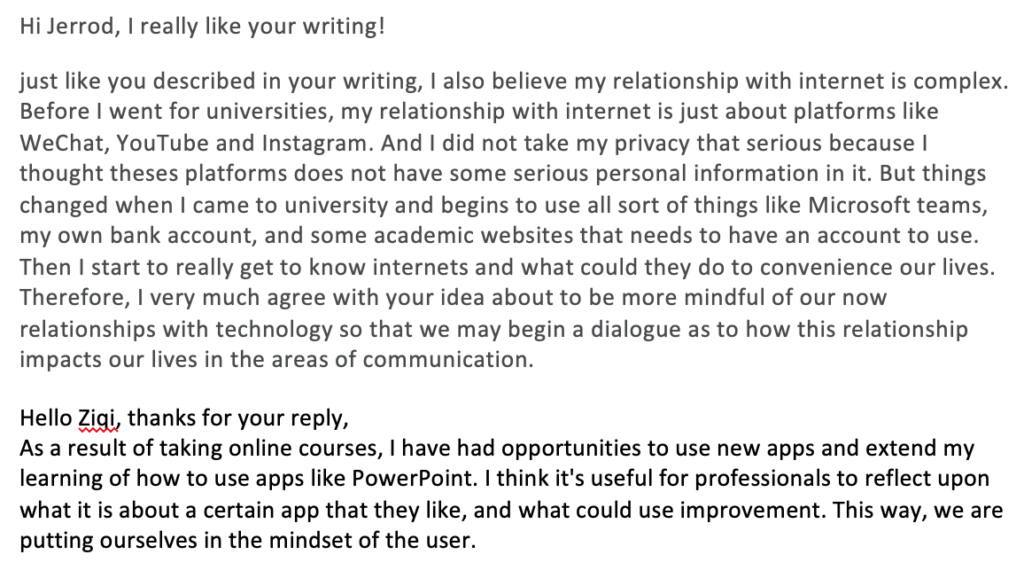

I found the perspectives from my pod’s posts on this topic to be rather insightful:

As part of my Topic 2 blog post, I discussed the immense value of providing opportunities for students to connect with their learning community in authentic ways in order to connect with peers and build a human-centred learning community: In the article, Teaching Online: A Guide to Theory, Research, and Practice, I was interested to read the perspectives of one professor, Alec Couros, who had reflected on an experience where one of his students shared his musical talents with the class as part of an improvised music performance. Couros wrote, “Open courses provide opportunities and connections that can serve as inspiring supports for students. The serendipity of networks is one of the reasons I’m a huge advocate for openness in course design” (2015, p.79). This kind of interaction is something that provides a glimpse into the unique potential of engaging in online learning, which is the social aspect of sharing and exchanging individual knowledge and expertise amongst diverse members of the student community for the sake of exchange.
This post inspired some interesting points for discussion amongst my pod members:
Jerrod, I really like your writing! I think you are doing a great job connecting the paper to your own experiences. I also started with face to face courses in the first two years in Univeristy, but to be honest, I rather call them blended courses becuase we always need to use our school website to access course materials, or use some other platforms like Top Hat, Mymathlab to answer short quizes which counts for our grades. Then I starts my third year with entirly online courses where I can review the classes whenever I want and I thought online classes are so great because I wont miss any critical points. But at the mean time, I rarely attend to any office hours due to the -15 hours timezone difference and sometimes I feel disconnected to the class. -Ziqili
In my Topic 3 blog post, when reflecting on the article, Chapter 4: Design Principles for Indigenous Learning Spaces, I connected ideas relating to the creation of OERs and the ways in which Indigenous groups transformed Open Learning environments to reflect their culture:
The First Voices database is an example of an Open Learning community that is engaged in the process of cultural restoration and community transformation, which is something that connects very much with the 5 Rs. Through this database, indigenous communities are able to collect and store words and language systems for the purpose of translating and sharing this knowledge with others to ensure their language, history and culture is preserved and restored. It is in this light that I am beginning to see the promise of how Open Learning environments can be used to create opportunities for meaningful change, promote equity and the exchanging of multiple perspectives.
The blog posts from my pod members allowed me to connect my Early Childhood Education studies to the topic of personalized learning:

In my Topic 4 blog post, I reflected upon the potential of Human-Centred Learning in Open and Distributed Learning contexts by examining the ways in which OERs are shared and built upon as part of an online community: a couple of years ago, after I began working in my community as a Circus Arts Educator, I came upon an online community of other Circus Arts Educators who put together an extensive list of games and resources to share and edit publicly. Since many of these circus arts educators worked internationally, they would remix and modify games based on experiences as a result of teaching in different cultural contexts. The list was presented as an editable spreadsheet, where games could be posted, categorized, shared, and remixed. In this way, the game list could grow as new games were created through remixing familiar ones and shared with others who would in turn continue with the process.
I found my pod member’s ideas about human-centred learning to be insightful, thus prompting my response:

As part of our Pod 2 Project, we examined the potential of peer groups to assist our Persona, Momoko, in Distributed and Open Learning contexts: English language learners face numerous challenges that may impact their learning. Korneev discusses challenges that English language learners commonly face and highlights that feelings of embarrassment while practicing English around fluent speakers, not having enough time to learn the language, as well as a lack of interaction with native speakers are typical challenges that English language learners experience (Korneev, 2020). To account for these challenges, Momoko may benefit from having a partner/peer/classmate who is in a similar situation as her, that can understand her and support each other during the learning process.
From completing these activities I learned about the ways in which distributed and open learning contexts can provide users with access to educational resources, allow users to interact with learning communities on the web, provide opportunities for users to transform their learning through cultural, personal perspectives and personal identity to create opportunities for meaningful change in their communities.
These things matter to me because as educators we value the belief that everyone should have equal access to education and that educational materials should be something that learners should be able to use freely to support and motivate their learning. There is also a lot of promise in allowing students opportunities to take ownership over their learning and share their understanding with others in ways that make sense to them.
Explore and engage with current literature on the distributed and open education movement & critically reflect on and articulate concepts around modality, pedagogy, and access, including distributed and open learning theory, online and open learning history, privacy laws, online learning communities, open research, and open data.
As part of my Topic 1 blog post, in reaction to the article, Ethical Challenges of Edtech, Big Data and Personalized Learning: Twenty-first Century Student Sorting and Tracking by Priscilla M. Regan and Jolene Jesse, I wrote about my own experience regarding user privacy protection and data mining: “Years ago, when I was first introduced to computer technologies in school, we did not have much instruction as to how to protect our personal information in online spaces or the consequences of accepting user license agreements. Much of what I have come to understand about digital citizenship and online privacy came as a result of learning about it during my first couple of years in University, when social media was commonly being used to connect with peers and other school networks. I also learned a lot through experiencing the many ways in which the use of technology has impacted my way of life. Even today, I feel I have a complicated relationship with technology, which affects how I approach using it in the classroom.”
My pod members had some great opinions on this topic, which made me reflect on my current practices in regards to protecting learner privacy:
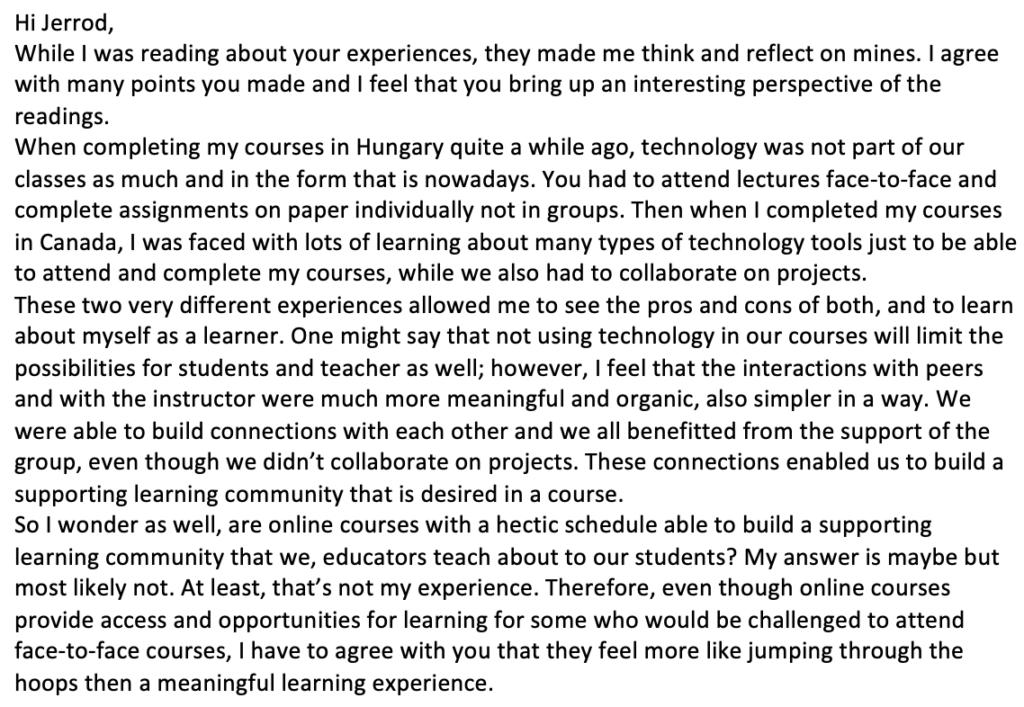
I also thoroughly enjoyed reading my pod member’s perspectives on the use of OERs and education technology:

In my Topic 2 blog post, in reaction to the article, Teaching Online: A Guide to Theory, Research, and Practice, I related my own experiences with online learning in order to examine social media engagement in open and distributed learning contexts: As a student, I have a different perspective regarding the integration of social media and online group projects. I feel that social media integration in the context of learning often feels forced, providing an inauthentic and artificial avenue for engagement and discussion, as there is no time or opportunity to create meaningful social connections; students have to meet deadlines and specific course expectations, including writing a specific number of posts per day, of a certain length, and each having to meet specific criteria for quality… Providing opportunities for students to share their knowledge with one another in ways that are authentic and not forced is something that I feel creates a climate of learning and cooperation that is lost in many of the designs of online courses.
This post generated the interest of my peers
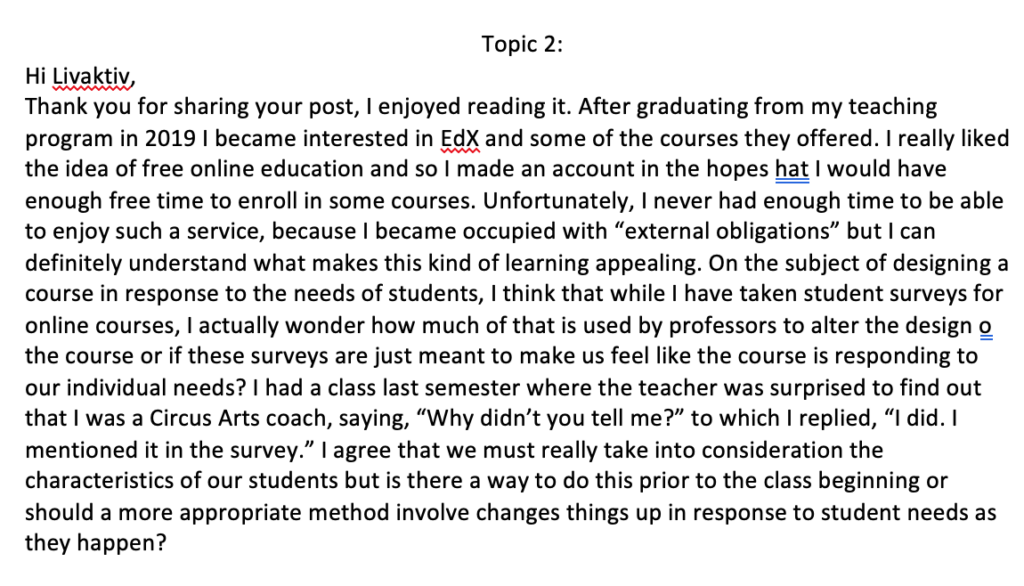
Hi Jerrod,
Thanks for this post. Your comment about the “rosy reflections of teachers who facilitate online courses, about how their students have embraced online learning, I tend to think that this isn’t the reality that many students experience” caught my attention. I don’t disagree with it, but it speaks to the lack of feedback that students often provide to instructors. It is true that some instructors don’t want the feedback, but others do, and they have a hard time receiving it.
For example, in the course I taught in June, I had less than 10% of the students complete the end of course survey. What makes matters worse is that the only students eligible to complete the survey are those that persist to the end of the course. The students that really struggle with the learning environment drop out before the course ends. Those are students that an instructor really needs to get feedback from.
What do you think of these issues? What do you think instructors or schools can do to get more feedback to instructors? Do you think this is a bigger issue in online learning than it is in face-to-face?
Ryan
As part of my Topic 3 blog post, as a result of reading A Guide To Making Textbooks With Students, I reflected on the ways in which OERs could be used in digital environments as a form of extending learning: “…in a digital learning context, this way of transforming and repurposing knowledge (through use of the 5Rs) supports the process of extension, whereby students are working with ideas and constructing ideas in such a way as to increase access to their peers and communities. The way in which Open Educational Resources may be built upon or reframed and remixed holds a lot of potential, as student are able to take their learning beyond the confines of closed environments and share it with others, not just amongst their instructors and peers, in new and meaningful ways.
In response to posts from my pod members, I reflected on the issue of digital redlining as it relates to higher learning:

In my Topic 4 blog post, as I reflected on the reading, Defining OER-enabled Pedagogy, by David Wiley and John Hilton, I wrote about the ways in which the “four-part test to determine the extent to which a specific teaching and learning practice qualifies as OER-enabled pedagogy” allows students opportunities to examine how their learning contributes to the wider community: the test presents ways for teachers to think about how assignments and projects can be presented I such a way as to have students think about the broader implications of their learning, in that their learning is not disposable but something that can inspire others, be built upon, and shared with the wider public. I think that this test is simple enough that it can actually be shared with students at the start of a project so as to help them understand the scope of their learning and how their efforts contribute to the wider learning community which they will be engaged with.
My pod member’s posts on this subject allowed me to reflect on the importance of soliciting student feedback when approaching opportunities to create Open Educational Resources:

As part of our Pod 2 Project, we examined current literature on Open and Distributed Learning approaches and their pedagogical underpinnings: Regarding Open Learning, it should be understood that, “a learning situation or process should be open to everyone, under any circumstances, at any place, and at any time” (Caliskan, 2012). Additionally, the “Open Learning Environments (OLE’s) are rooted in learner-centered design principles and highlight activities and contexts that support the individual’s efforts to understand” (Caliskan, 2012)… Distributed learning environments are geared towards a specific audience or group such as in a classroom setting. Specifically, the work required is “distributed over a period of time so that the learner must integrate the various separated parts of material into a unique entity” (Kirkley, 2012).
In completing these activities, I learned that there are different ways to approach designing distributed and open learning environments based upon one’s philosophy regarding the use of OERs and open pedagogy practices.
What I learned matters to me because as a teacher I feel that it is necessary to examine modern approaches to open pedagogy, including the ways in which educators use OERs in the classroom, in order to design educational experiences that meets the needs of students and align with one’s own teaching style.
Examine and reflect upon the potential for equitable access for all learners in online and open learning contexts.
In my blog entitled, Increasing Engagement Through Promoting Equity in Digital Learning Environments, I highlighted the work of John Spencer and useful strategies for supporting equity in online learning contexts: In a classroom environment, focus, attention, and engagement can be monitored and sustained. At the home, frequent distractions, irregular schedules, and technical issues notwithstanding (family members hogging the wifi) students feel as though their productivity is stifled... therefore, as teachers, we must think about how to improve our practice by focussing on equity and empathy.
To meet the needs of students, Spencer introduces strategies that include: providing access to technology, training on how to use technology, maintaining frequent communication with students and families, providing flexible due dates and scheduling, providing linguistic and UDL support and very importantly, paying attention to power dynamics, as gender and racial issues persist in online learning environments.
My pod embers had some interesting questions to share, which made me think about how technology can increase group social interactions and engagement:
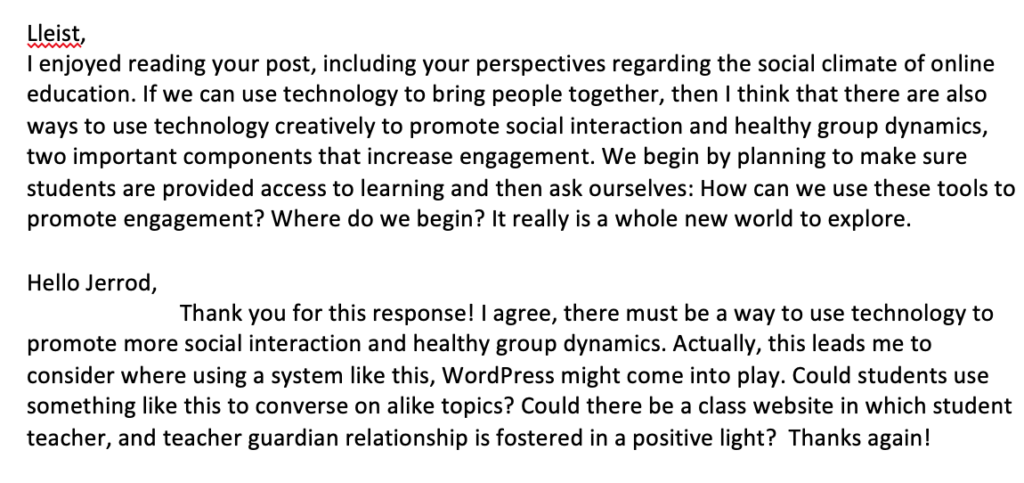
As part of my Topic 2 blog post, When reflecting upon the readings, Openness and Education: A beginner’s guide and Teaching Online : A Guide to Theory, Research, and Practice, I outlined the ways in which Distributed Learning provides access to learners both in class and at home: My first experience with online education and blended learning occurred when I first enrolled in university studies after a 10 year hiatus and found that each of my face-to-face courses had some kind of online component, presented through the Moodle platform. My math courses, for example, offered video-taped lectures of my professor presenting the lesson of the day, which students could access at any time... for the most part this allowed students who were learning via distance learning or stuck at home with the flu an opportunity to listen to the same lecture that students were seeing in class.
This inspired some interesting reflections from my pod members:
Hello Jerrod,
Thank you for sharing your thoughts on the reading provided for this week. I found your point about most classes, even face-to-face classes having an online component to be almost surprising as I hadn’t actually stopped to fully consider this. Even though I will be entering my fifth year of university education this fall I hadn’t actually realized how much technology is used within the face-to face lecture style. I am now flooded with the memories of Coursespaces, Brighsaces, D2L, and more. I remember needing to write blog posts, take online quizzes, refer to posted lecture notes, and submit any assignments through a dropbox platform. I too now understand the arisen question “why commute to campus”? However, like you mention purely online classes are not as rosy as some may like to think. Especially after pandemic learning I couldn’t agree more with your proposed cons to online learning. ” Un-organic communication related to prescribed word counts, topics, a number of blog posts, communication grading, and so on…”
Overall, your blog has allowed me to really reflect on my own perspectives of the readings, my response, and how I might interact with technology-based classes in the future.
Thanks again! -Lleist
As part of my Topic 3 blog post, I commented on how the use of Open Educational Resources creates a climate that supports equity and the sharing of perspectives amongst groups of students: Since OER’s may be accessed through Creative Commons Licenses, they provide unique opportunities for students to use them in ways that are characterized by what is called the 5 Rs: reused, retained, redistributed, revised, and remixed. This presents opportunities for students to use open access resources to create content, remix and reframe ideas in new ways and for new audiences. I feel that this notion connects with much of what we do as teachers by providing students opportunities to create projects that remix and repurpose concepts to reflect their understanding.
I reacted to my pod member’s posts on the topic, which allowed me to reflect on the ways in which schools approach providing learners access to online education:

In my Topic 4 blog post, I reacted to the article, Defining OER-enabled Pedagogy, by David Wiley and John Hilton by thinking about how assignments and projects could be designed to allow for flexibility and support for different perspectives, all of which contributes to the creation of an equitable learning environment: I certainly think there are ways to approach creating assignments and projects that support all four parts or tasks of the OER test. I feel this test would work well to inform inquiry projects where students have opportunities to transform their learning through open engagement with classroom and online communities. When students are made aware that their work is going to be shared with the public, it might help them to consider their audience as well as the ways in which they go about remixing ideas and information in their daily experiences to present something new.
My pod’s post on this subject allowed me to reflect on the ways in which my previous online course instructors incorporated OERs and Open Pedagogy Practices in their courses:

As part of our Pod 2 Project, we outlined how Distributed and Open Learning environments each had attributes that could assist our persona in accomplishing her learning goals: “Open Learning Environments (OLE’s) are rooted in learner-centered design principles and highlight activities and contexts that support the individual’s efforts to understand” (Caliskan, 2012). In this case, Momoko may encounter approaches such as publicly available resources, recordings of the lecturer, connections with diverse people asynchronously though blog sites, and flexibility in terms of completion time and learning methodologies…“technology-based distributed learning environments integrate the interactive capabilities of networking, computing, and multimedia with learner-centered content” (Kirkley, 2012). Viz, Momoko could encounter safe discussions because the class is closed to the public, can learn together with a joint group, and could also choose any environment in which she wants to learn.
In completing these activities I learned about the potential for open and distributed learning contexts can create equity through providing users with open educational resources, and creating a learning environment that is responsive to their learning needs.
What I have learned matters to me because, as an educator, I recognize the value of designing learning environments that accommodate student’s needs and learning preferences. By understanding how open pedagogy practices may support student learning we may create learning experiences that support equity and the sharing of multiple perspectives.
Conduct research into and critically reflect upon emerging and future educational technologies
In my blog entry, Current and Future Technologies in the Classroom, I reflected upon my use of current technologies as well as the potential of technology in the classroom to enhance student engagement and learning:
When I think about how all of these different technologies came together to create an integrated learning experience for my students, I feel there is a lot of potential for technology to motivate student learning and increase engagement. While our district does not have the money to equip every school with things like virtual reality headsets and 3D printers, we are still able to introduce students to technology in ways that show them the potential of how these tools may be used to promote learning.
My pod members also shared their opinions on how teachers can integrate the use of technology in classrooms, which prompted my reflection on the issue:
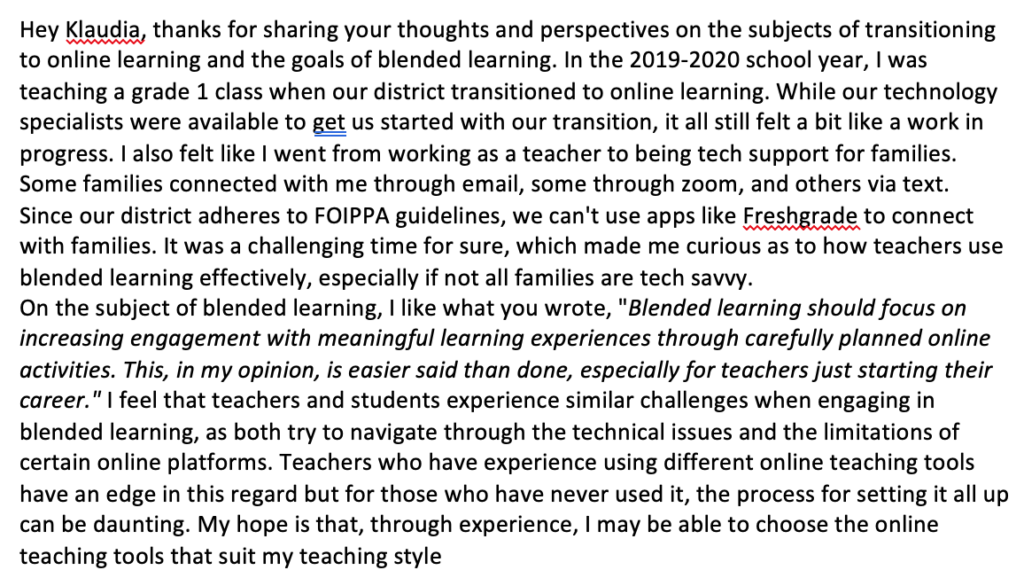
From completing this activity, I learned how different technology tools may serve a different purpose in the education of students and that educators should consider what tools they have available to enhance learning in online and face to face learning environments.
What I learned matters to me because technologies in the classroom are constantly changing and as such we must approach the use of technology based on the specific needs of our students. It is also important for teachers to consider the ways in which emerging and future technologies can be adapted to increase student engagement in subjects and encourage their motivation to use them in new and meaningful ways.
Practice digital, networked, and open literacies in support of learning about distributed and open learning
Throughout my experience in taking this course, I have used the LMS platform Brightspace to connect with peers and access learning content:

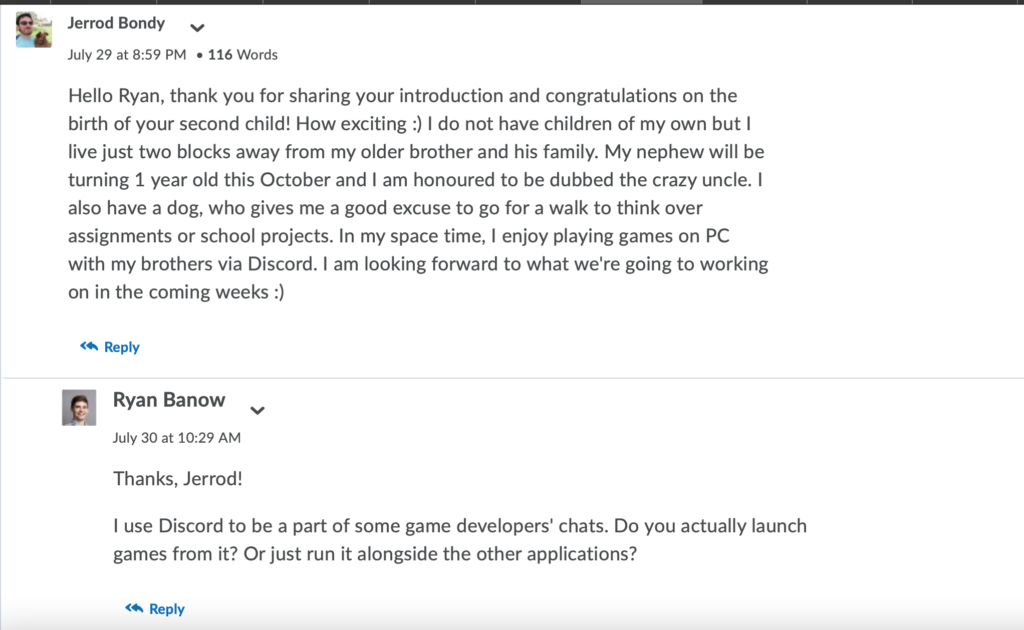
I have also created this blog site, where I have authored several entries on the subject of Distributed and Open Learning:

I have engaged with my peers through the use of chatrooms, including Mattermost, to engage in discussions with my peers and provide updates on our collaborative efforts:

I have used online technologies including Zoom and Google Docs to share resources, discuss assignments, work on projects, and coordinate with my peers:
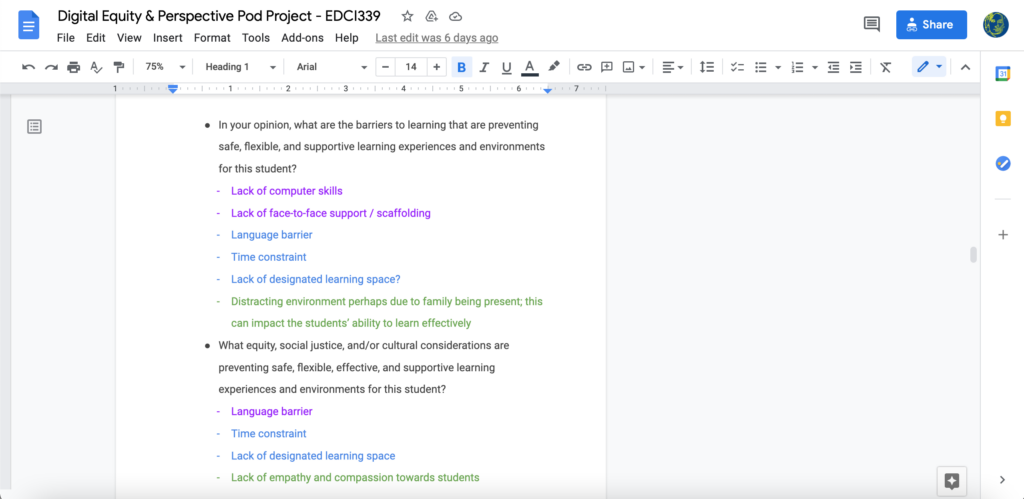
I feel that the use of these different technologies each served a unique purpose in my learning and while, at times, it was a little challenging to manage everything, I could see where each of these would fit in terms of providing avenues for discussions and group work. I think that while LMS platforms do a good job of merging many of these technologies together under one umbrella, there is a lot of value to incorporating the use of technologies that exist outside the LMS in order to document work and allow users to assume more ownership and control over their learning.
Part 2: “Showcase” Blog Post
Link to updated post: Here is my link to my updated Topic 3 blog post on the subject of how open pedagogy practices and the use of OERs can make a positive impact in local communities.
Link to original version: Here is the link to the original version of my Topic 3 blog post reflecting my understanding of the course readings.
The changes I made to my original post reflect my interest in the subject of open pedagogy and open educational resources as tools to enact meaningful change and bring learning communities together. Since many of the summer courses I have taken this year related to the use of technology to break barriers and provide users access to education, I wanted to share a unique perspective on how the use of technology has impacted my local community as well as some ideas on how instructional approaches support open pedagogy practices. In my original post, I offer my reflections on the three readings we had for our Topic 3 blog, including how I related what I read about designing indigenous learning spaces to what Ktunaxa knowledge keepers have been doing to preserve their language and culture through the use of technology. As a result of further readings, I felt the need to revisit this topic so as to expand upon the story and context behind the creation of an open educational resource, the First Voices indigenous language website. Through an examination of the process of what it took to create this resource, I felt that it would give readers a perspective as to how similar projects could tackle problems and present solutions for the benefit of their community.
Final Reflection
When reflecting upon my learning over the last few weeks of this course, I feel that much of what I now know about Distributed and Open Learning has come as a result of my experiences using different communication technologies in the context of my learning. I remember writing in my first introductory post that I wasn’t sure what Distributed and Open Learning meant and that I had no expectations about what I was going to learn or what I wanted to learn more about. I feel that one of the enduring ideas that I will take away from this course is how teachers can involve students in the creation of Open Educational Resources, as I find there is a lot of potential to approach subjects with the idea that students’ learning can be documented, shared and accessed using online apps and technologies. It is fortunate that this course in particular comes at the tail end of my 5th year education studies, as I have been taking online courses since January of this year. As such, I have been able to reflect upon many of the things my course instructors have done to motivate learning and promote online social connections, and design ways for us to demonstrate our understanding of concepts in both distributed and open learning contexts. Looking forward, I feel that I have a better grasp about how to incorporate open pedagogy in my classroom and feel more prepared to design online learning experiences for students that offer ways for them to feel more engaged. Additionally, I hope to continue to use this blog in my professional practice as a useful education tool. Thank you for reading, and check back soon for more updates!
